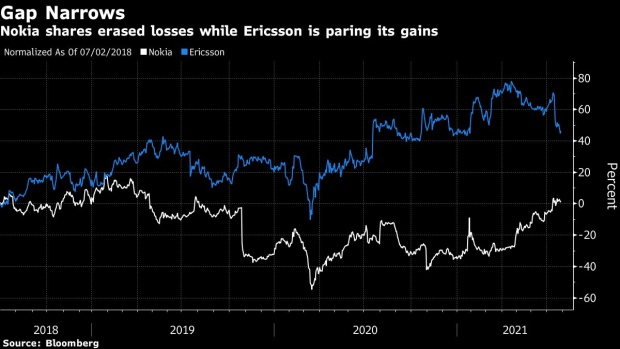Jul 29, 2021
Nokia Soars After Raising Its Guidance More Than Expected
, Bloomberg News

(Bloomberg) -- Nokia Oyj topped estimates for sales and profit last quarter, allowing it to raise its guidance more than expected, with the mobile networks business in particular set to see a much bigger bounce this year than previously forecast.
The Finnish maker of 5G equipment now sees an operating margin of 4-7% for Mobile Networks this year, compared with earlier guidance that had left room for loss. Nokia’s shares gained more than 6% when trading started in Helsinki.
The second-quarter results are the latest indication that a turnaround strategy launched before the pandemic is paying off. Nokia had already signaled it was ready to raise its guidance, but the company still managed to exceed analyst expectations for quarterly sales and operating profit.
Even so, Chief Executive Officer Pekka Lundmark sought to temper expectations by noting that the rest of the year won’t be without its challenges.
Despite a “strong” start to 2021, “we still however expect to face the earlier communicated headwinds in the second half, particularly with market share loss and price erosion in North America,” he said in Thursday’s statement.
Key Figures -
- Nokia now expects to reach a comparable operating margin of 10-12% this year with sales in the range of 21.7 billion euros ($25.7 billion) to 22.7 billion euros. It previously forecast a margin of 7-10% and sales of up to 21.8 billion euros.
- Net sales rose to 5.31 billion euros last quarter, more than the average analyst estimate of 5.16 billion euros. Comparable operating profit reached 682 million euros.
- The Mobile Networks unit, Nokia’s biggest, benefited for a one-time software deal worth about 80 million euros, the company said.
Nokia has managed to respond to growing demand without letting costs swell. That’s as a combination of technology fixes, savings and job cuts pays off. The company has also had a little help from outside as geopolitical tensions deliver a blow to its main competitor. The company recently won a 4% slice of China Mobile Ltd.’s 5G tender. Its arch rival Ericsson AB got just 2%, as it absorbs the fallout of Sweden’s decision to ban Huawei Technologies Co. and ZTE Corp.
For Nokia, the Chinese order helps CEO Lundmark move ahead with his turnaround strategy, which includes slashing the workforce by as many as 10,000 people.
Nokia’s recovery path started in late 2019, when then-CEO Rajeev Suri halted dividends and instead reinvested the money in research and development. That’s after the company was forced to acknowledge its 5G offering was inferior and more expensive to make than rivals’ products.
“We’re now seeing the fruits of all the labor to improve 5G products that started about six months before Suri stepped down as CEO,” Kimmo Stenvall, an analyst at OP Group in Helsinki, said by phone before Thursday’s report. “The impact of Lundmark’s turnaround is probably pretty small still at this stage, given it started so recently. The benefits will eventually be seen in higher revenue and an improved gross margin.”
Nokia’s stock has risen more than 55% since the start of the year and several analysts have upgraded the shares. Ericsson is up less than 2% over the same period.
“The turnaround story has gripped the Nokia stock in recent months,” Stenvall said. “It seems people are ignoring weaknesses, and trust that the new management is able to push through changes.”
Get More
- See the second-quarter numbers here.
(Retops with share reaction)
©2021 Bloomberg L.P.





